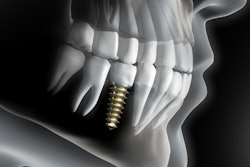
Implant-supported crowns can be made in both fully and partially digital workflows. The occlusal adjustment and total adjustment times of the fully digital workflow, however, are significantly shorter than the partially digital workflow, according to a study in the Journal of Prosthetic Dentistry.
Researchers studied a group of 28 participants who had two adjusted implants in posterior sites, each with titanium abutments and a splinted monolithic zirconia restoration. Half of the participants had crowns produced using a digital scan and a cast-free digital workflow, while the other 14 individuals had restorations made using a conventional impression and a partially digital workflow.
"A completely digital workflow can be used with a combination of [intraoral scans] and CAD-CAM without a physical cast, simplifying clinical and laboratory procedures and reducing operator-dependent factors and material-related problems," wrote the authors of the report, led by Dr. Hamidreza Rajati Haghi, an associate professor in the prosthodontics department at the Mashhad University of Medical Sciences School of Dentistry in Mashhad, Iran (J Prosthet Dent, May 4, 2022).
The study aimed to better understand how the clinical fit and adjustment time varied for implant-supported crowns produced by a partially digital workflow versus a fully digital one. To be included in the study, participants had to be older than 18. If a study candidate was a smoker, they smoked fewer than 10 cigarettes per day.
All participants had received two adjacent implants in posterior sites. They had similar dental implant systems, at least a 3-mm distance between the two implants, at least 1.5-mm distance between implants and the adjacent tooth, and have a 25° maximum angle between implants.
In the fully digital workflow, scan bodies were screwed into the implants. An intraoral scanner captured the location of the implants, adjacent teeth, opposing arch, and occlusion. The data was then sent to a dental laboratory, where a technician cemented zirconia crowns on custom titanium and abutments.
In the partially digital workflow, an open-tray implant impression was made, and a cast was poured instead. The cast was then scanned using a laboratory scanner, and the remaining steps in the process were similar to the fully digital workflow group.
In all cases, the authors designed the restorations in a CAD software program with a 40-mm cement space, and the same dental technician made minor adjustments. Abutments and contoured zirconia crowns were milled and sintered, while staining and polishing were done manually.
A blinded researcher delivered an envelope containing each patient's prosthesis and custom abutment. The abutments were tightened on the implants for clinical assessment and adjustment.
The mean occlusal adjustment time and the total adjustment time in the fully digital group was significantly shorter than the times in the partially digital group, while the mean adjustment time for the proximal contacts was similar. All crowns had acceptable clinical and radiographic fit.
"The present study indicated that the total clinical adjustment time was significantly shorter in a cast-free fully digital workflow than that in a partially digital workflow for a 2-appointment implant-based restoration," wrote the authors of the report.
The authors pointed to some additional benefits of a fully digital workflow, including a straightforward workflow, standard manufacturing quality, and reduced possibility of damaged porcelain. The study, however, was not without its shortcomings, such as the results not being applied to all digital workflows or all implant and abutment types. The authors of the report stated that more extensive studies should be done.
"The fabrication and delivery of an implant-supported restoration was possible in two appointments, with no need for remakes in any of the treatments, and both methods were clinically acceptable," the authors concluded.



















